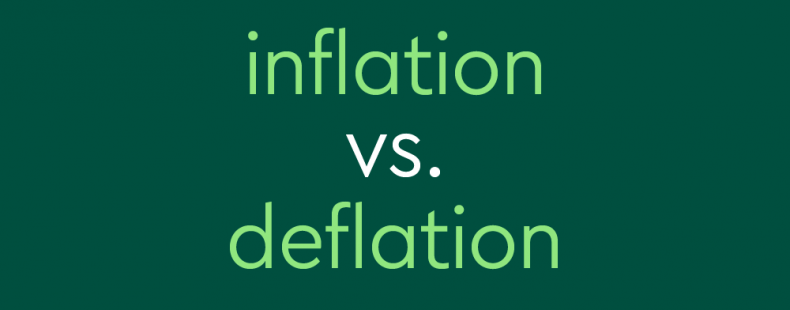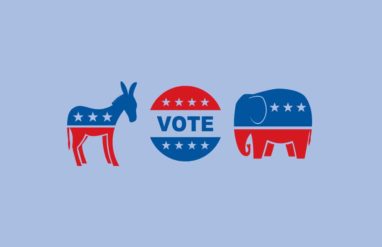You’ve probably noticed a lot of talk about inflation in the news. But what exactly is inflation, and why is it bad? And what about deflation? Inflation and deflation sound like opposites, so why do they both have negative connotations?
Both terms have to do with spending power—how far your money goes. And both are considered indicators of the direction that an economy is going. Too much of either is often a bad sign.
Of course, it’s more complicated than that, so we’re here to simplify it for you. For the low, low price of a few minutes of your time, we’ll break down the difference between inflation and deflation with simple explanations and real-life examples—and we’ll even throw in some basic definitions of related terms like hyperinflation, disinflation, stagflation, shrinkflation, and skimpflation. Time is money, people, so let’s dive right in!
⚡ Quick summary
Inflation is a general decrease in the value of money due to increased prices and a higher money supply—it’s what happens when the same things cost more and more. Deflation is a general increase in the value of money due to lower prices and a low money supply—it’s often linked to higher unemployment and lower wages (since businesses aren’t charging as much and therefore aren’t profiting as much).
What is inflation?
In economics, inflation is “a persistent, substantial rise in the general level of prices related to an increase in the volume of money and resulting in the loss of value of currency.” In simpler terms, inflation is a situation in which your money doesn’t buy as much as it used to because things cost more.
Here is a simple example of inflation. In 2000, a moviegoer was able to buy a movie ticket for about $5. Fast forward to today, when the average cost of a movie ticket is around $10. In 2000, a person with $10 could buy two tickets, but today that same $10 can only buy one ticket. The currency has less value than it did before due to inflation.
You may have heard your parents or grandparents talk about how milk and bread used to cost so much less. That’s inflation.
Typically, inflation is discussed in terms of macroeconomics, the branch of economics dealing with the broad and general aspects of an economy. In this context, inflation is what happens when the purchasing power of money decreases in general (for buying anything—not just movie tickets and groceries). When their money has less value, people aren’t able to buy as many things. This has an effect across the economy: some people have to limit the amount of luxury items they buy, while others may struggle to cover the costs of necessities, such as food and rent. Businesses sell fewer products, and the economy in general suffers.
An extremely high rate of inflation over a short period of time is called hyperinflation. As you might expect, hyperinflation results in the negative effects of inflation happening more rapidly or becoming more severe.
When statistics are said to be adjusted for inflation, it means that the inflation rate has been taken into account so that things (such as the profits made in different decades) can be compared fairly.
The consumer price index (CPI) is a measurement of how much the price of goods has changed over a period of time. Central banks often use CPI data to try to figure out the rate of inflation or deflation.
What are stagflation, shrinkflation, and skimpflation?
The word stagflation refers to a situation in which an economy is experiencing high inflation, high unemployment, and stagnant economic growth.
Shrinkflation and skimpflation are terms for phenomena that can happen as a result of inflation. Both negatively impact consumers.
Shrinkflation refers to a situation in which the size or amount of individual products is reduced while their price remains the same. Some businesses use this method rather than raising prices (though, in some cases, the price of the reduced-size product may eventually be raised). This allows the business to increase profits, such as to make up for profit lost due to rising production costs resulting from inflation. The idea is that consumers are less likely to notice reduced size or amount than a price increase. Of course, shrinkflation is still bad for consumers because they are getting less for their money.
Shrinkflation is especially discussed in the context of packaged consumables, most often food and beverage products, such as boxes of cereal. The term shrinkflation is often credited to economist Pippa Malmgren.
Skimpflation is similar. It refers to a situation in which the services offered by a business are somehow decreased, such as in quality or quantity, while still remaining at the same price (or eventually rising in cost). Just like with shrinkflation, such skimping is often an attempt to increase profits, including as a way make up for those lost as a result of rising production or labor costs caused by inflation. Skimpflation is often experienced as lower quality service due to lack of staff or lower efficiency. For example, an amusement park may charge the same price for an admission ticket despite the fact that half of the rides are closed due to a shortage of workers. The term skimpflation was first used in an October 2021 article by journalist Greg Rosalsky.
Despite the fact that many economists consider shrinkflation and skimpflation to be versions of inflation, the shrinking and skimping methods associated with these phenomena are sometimes used as business tactics even when the current inflation rate is not high.
What is deflation?
In economics, deflation is “a fall in the general price level or a contraction of credit and available money.” In simpler terms, deflation means prices are low and money has high value.
Deflation is sometimes thought of as the reverse of inflation. It can happen when businesses lower prices due to decreased demand or increased supply (and competition).
For example, say a company sells a toy at $15, but nobody buys it. The company responds by lowering the price to $10. People expect the price to continue to drop, so they wait. Wanting to recoup at least some of their losses, the company sets the price at $7.50, which is half the original price. The customer’s money has twice the value it had before. This is deflation.
At first, deflation may not sound so bad. Money having high value is good, right? Well, if people know that prices are going down, the common belief is that they won’t spend money at all in hopes the prices will go even lower. Lower prices are good for customers, but bad for businesses. Low profits mean businesses will hire fewer employees and keep wages the same (or even lower them). This cycle is sometimes called a deflationary spiral. Deflation means money is worth more, but there is also less of it due to lack of spending, low wages, and high unemployment.
deflation vs. disinflation
Disinflation is not the same thing as deflation. Disinflation is a slowdown of the rate of inflation.
Can you explain the difference between the cost and price of something? Learn the difference here.
What causes inflation and deflation?
Economics is complex—inflation and deflation can be the result of many different factors. In general, though, both inflation and deflation go hand in hand with the concept of supply and demand.
Typically, inflation is thought to be caused by two different situations. Demand-pull inflation occurs when demand for things is very high but the supply has remained the same—businesses will charge more money for the same products. Cost-push inflation occurs when demand remains the same but the supply decreases due to increased production and/or labor costs.
Many economists expect inflation to be one of the effects of the COVID-19 pandemic, due in part to supply chain disruptions and high demand for products and services.
Likewise, deflation is typically thought to result from two different situations. If supply remains the same but demand is low, money isn’t being spent and businesses may need to lower prices to try to sell their supply. Conversely, deflation can result from demand remaining the same but the supply increasing, such as from lower production costs. High supply means competition, which leads to lower prices as businesses compete over the limited amount of customer demand.
Examples of inflation and deflation used in a sentence
Here are some examples of the words inflation and deflation used in sentences in the context of economics.
- High inflation rates are often blamed on poor management of the economy.
- Economists and government officials are concerned about how the COVID-19 pandemic will impact inflation in the next several years.
- In the 1990s, Japan suffered a 10-year recession known as “the Lost Decade” as a result of significant deflation.
- Deflation heavily contributed to the bleak economic landscape during the Great Depression of the 1930s.
- Central banks sometimes try to promote inflation to counter periods of deflation.














